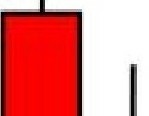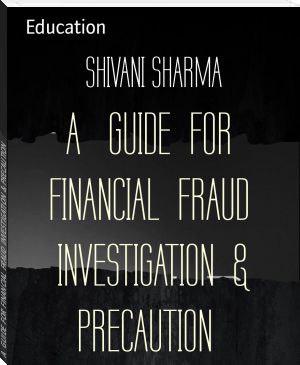Day Trade For Living by Andrew Aziz (best thriller novels to read txt) 📖

- Author: Andrew Aziz
Book online «Day Trade For Living by Andrew Aziz (best thriller novels to read txt) 📖». Author Andrew Aziz
reverse flag), and that is an indication that the price is probably going to continue to drop. If I get in and I hold for a few minutes and the price stays flat, I get out, no matter what happens after that. I may be wrong, but so be it, I don't like to expose my account to the unknown. I need to be in the right setup, and if it is not ready yet, I'm out. If I get into the profit zone, I can start adjusting my stop, first to break-even, and then to the low of the last 5-minute candle. I will then keep adjusting my stop as I move up.
You must realize that almost all of the big moves will eventually be corrected. What goes up, must come down. In Reversal Strategies , one of the main advantages is the opportunity to watch stocks that are running up, while simultaneously calculating possible resistance points and areas that could provide a good reversal opportunity. This allows you to resist being impulsive and rushing into the trade. You can instead take your time to watch the trade develop and wait for the momentum to begin to shift.
An important metaphor many traders use when talking about Reversal Strategies is that of a rubber band. When stocks become reall y stretched out to the downside, then inevitably they're due for a correction. So, when a stock is really squeezing down, you will know that at some point it 's going to make a bounce, and you want to be in there for the bounce. What you definitely don' t want to be is to be the one still selling. As I said before, that 's like "catching a falling knife". If stocks are dropping, you want to wait for the confirmation of the reversal. This will probably be the first I-minute or the first 5-minute candle to make a new high. That's my cue to jump in. I set my stop at the lows.
Bottom Reversal


Boa in control
Sell erspush lower
Hamm er Doji
fndecision
0

Bulls in c-0ntrol
Bvyers push higher
Bottom Reversal Strategy with an indecision hammer candlestick formed as sign of entry.
This beautiful illustration on Emergent BioSolutions Inc. (EBS) shows a perfect reversal that I found using my stock scanners. An indecision candlestick at the bottom of the downtrend signifies a potential reversal , and as you see right after that you see a big swing back up. I took this trade right after seeing indecision Doji, and kept my stop at the low of that indecision candlestick.
Example of a Reversal Strategy on EBS.
The biggest advantage of Reversal Strategies is that they overcome the difficulty of anticipating when stocks will make major moves. You will probably miss the moment when the stock starts to sell off, and you won' t have the time to short the stock for profit, but you can always prepare for the reversal trade.
Another example:
Example of a Bottom Reversal Strategy on ALR.
I found ALR (Alere Inc.) on June 27, 2016 at 10:57 a.m., using a software program that scans the stock market and lets me know exactly what I want to know. See the image below:
Example of my Bottom Reversal real time scanner for ALR.
My scanner, at 10:57 a.m., showed me that ALR had seven consecutive candles to the downside, a relatively low float (80 million shares) and a relative volume of 1.21, which meant it was trading higher than usual. I actually did not take this trade because I missed my entry, but I wanted to show you what overall trading strategies look like for bottom reversals.
When you're looking at reversals, you want to make sure that you only trade extremes. The example we just saw was a stock that made an extreme move to the downside before that move reversed. A stock that's been selling off slowly all day long usually isn't suitable for a reversal. Instead, it's helpful to think of stocks the way you think of rubber bands - you want to see them really stretched out to the downside or, for short selling, really stretched out to the upside. You want to see the big extension , which means that you want to see considerable volume. Once you do, you then look for a couple of key indicators that will suggest that the tide may be about to turn, and that 's when you take the position. I've
said it many times: what goes up, must come down. Oftentimes these stocks will give up days' and weeks' or years' worth of price gain in just a matter of minutes. It is very critical to be able to time the reversal.
I'll say it again: the key to the success with top and bottom reversals is trading the extremes. How do I quantify these extremes? There are a few things I look for:
An extreme RSI above 90 or below IO will pique my interest.
A candle outside of the Bollinger bands is also going to interest me.
Finally, seeing five to ten consecutive candles ending with an indecision candle or a Doji is definitely going to catch my interest. These candles usually show that sellers are losing their control while buyers are becoming more powerful, and that indicates the end of a trend.
I will add a caveat to that final point: there will be times when you will have five to ten consecutive candles without much price action. They may be drifting down slowly, but not quickly enough for you to sense that it's a good reversal. You must look for a combination of these indicators all occurring at the same time. Never sell short just because the prices are too high. You should never argue with the crowd's decision, even if it doesn' t make sense to you. You do not have to run with the crowd - but you should not run against it.
Utilizing all of these different factors will create the strategy that has been extremely successful for me due to its incredible profit-to-loss rat io. Your profit-to-loss ratio is your average winners versus your average losers. Many new traders end up trading with a very poor profit-to-loss ratio because they sell their winners too soon and they hold their losers too long. This is an extremely common habit among new traders. The Reversal Strategy, however, lends itself to having a larger profit-to-loss ratio . To return to the rubber band analogy, by following such a strategy you will always buy stocks when the rubber band is stretched as far as it can go. When you time this right, you're in as the rubber band snaps back and you can then ride the momentum right back up.
To summarize my trading strategy for the Bottom Reversal Strategy:
I set up a scanner that show me stocks with four or more consecutive candlesticks going downward. When I see a stock hit my scanner, I quickly review the volume and level of resistance or support near the stock to see if it is a good trade or not.
I wait for confirmation of a Reversal Strategy: (1) formation of a bearish Doji or indecision candle, (2) candlesticks being very close or outside of the Bollinger Bands, and (3) the RSI must be lower than 10.
When I see the stock make a new 5-minute high, I buy the stock.
My stop loss is the low of the previous red candlestick or the low of the day.
My profit target is (1) the next level of support or (2) VWAP (Volume Weighted Average Price, described later in this chapter) or moving averages or (3) the stock makes a new 5-minute high, which means that the buyers are once again gaining control.
Top Reversal
A Top Reversal is similar to a Bottom Reversal, but on a short selling side. Let's take a look at Bed Bath & Beyond Inc. as it traded on June 23, 2016. My scanner showed BBBY going up at 10:18 a.m. with six consecutive candles. It had a relative volume of 21.50, which meant it was trading significantly higher than usual. That was because, as discussed, retail traders look for unusual trading volume.
I took this trade and made a good profit on it. The candlesticks were not outside of the Bollinger Bands, but because it was trading with very unusual volume, and forming a nice Doji on top, I decided to take the trade. I shorted stock when a new 5-minute candlestick was made, with my stop being the break of the high of the last 5-minute candles. I covered my shorts at $43.40 for a 60-cent profit when the stock made a new 5-minute high.
Example ofmy Top Reversal real time scanner for BBBY.
A !)Qji tl!rnlle 1k,k lw wing
....-------. ..........
the ir- co:nt rol .and that at
' 411
anyti me .11,
ha p e n.
1 • .,.
r,i!!'l/ers al can
I r1, r-r9
6 ¢ T
-------
□- +. ....
-----...:: .,,.
/
..:: ..
...
.....
D■■DD□□□□□■■■- □ -
...
...
E xa mple of a Top Reversal Strategy on BBBY.
To summarize my trading strategy for the Top Reversal Strategy:
I set up a scanner that shows me stocks with four or more consecutive candlesticks moving upward. When I see the stock hit my scanner, I quickly review the volume and level of resistance or support near the stock to see if it is a good trade or not.
I wait for confirmation of a Reversal Strategy: (1) formation of a bearish Doji or indecision candle, (2) candlesticks being very close or outside of Bollinger Bands, and (3) the RSI must be higher than 90.
When I see the stock make a new 5-minute low, I start short selling the stock.
My stop will be the high of the previous candlestick or simply the high of the day.
My profit target is (1) the next level of support or (2) VWAP or moving averages or (3) when the stock makes a new 5-minute high, which means the buyers are once again gaining control.
Some day traders focus exclusively on reversal trades and actually base their entire careers on them. Reversal trades are certainly the most classic of the various strategies with a very high risk-reward ratio and, interestingly, you will always find stocks that are good candidates for reversal trades. I myself am trading more and more reversal trades these days, especially during late morning and afternoon trading. However, reversal trading is not yet the cornerstone of my trading strategies. I am more of a VWAP trader and Support or Resistance trader, which I will explain later.
Moving Average Trend Trading
Some traders use moving averages as potential entry and exit points for day trading. Many stocks will start an upside or downside trend respecting their moving averages in I-minute and 5-minute charts as type of a moving support or resistance line. Traders can benefit from this behavior and ride the trend along moving average (on top of moving average for going long or below moving average for short selling).
I have been asked why moving averages are becoming support or resistance, and the answer is because many traders are looking at these lines and making decisions based on them. Therefore, they have a self fulfilling prophecy effect. There is no fundamental reason behind moving averages being a support or resistance line.
I use 9 and 20 exponential moving averages (EMA) and 50 and 200 simple moving averages (SMA). I won't go into the details of what moving averages are and the differences between simple and exponential in order to keep this book short. You can, however, do a Google search and find information about these moving averages or you can of course contact me directly through www.Vancouver-Traders.com with any questions you may have. Your charting software will haves most of the moving averages built in. They are ready to be used and there is no need to change the default setting in them.
Let's take a look at the chart below for NUGT to see how you could trade based on 9 EMA in a I-minute chart.
Example of a Moving Average Trend Strategy on NUGT.
As you can see, at 15:06 pm I noticed NUGT has formed a Bull Flag. I saw that a consolidation period was happening on top of 9 EMA.
 The desire to acquire knowledge about the surrounding world and human society is quite natural and understandable for a person. Life is so developed that an uneducated person will never occupy a high position in any field. Humanity in its mass, and each person individually, develops objectively, regardless of certain life circumstances and obstacles, but with different intensity. The speed of development depends on the quality of training.
The desire to acquire knowledge about the surrounding world and human society is quite natural and understandable for a person. Life is so developed that an uneducated person will never occupy a high position in any field. Humanity in its mass, and each person individually, develops objectively, regardless of certain life circumstances and obstacles, but with different intensity. The speed of development depends on the quality of training.




Comments (0)